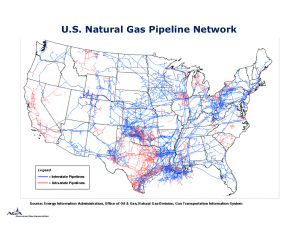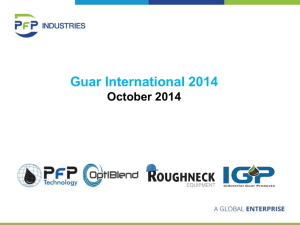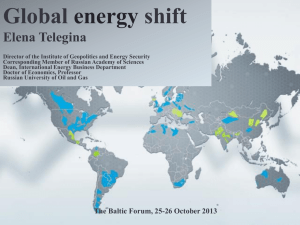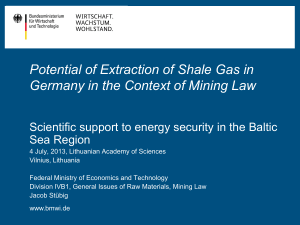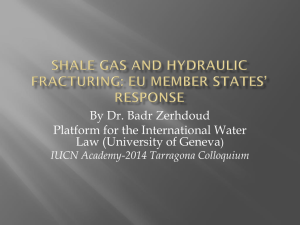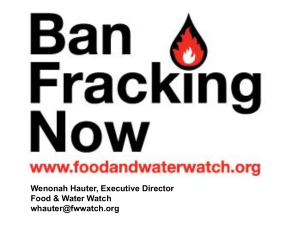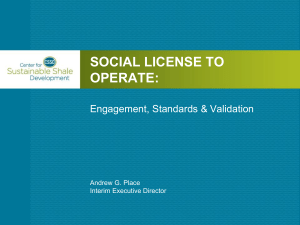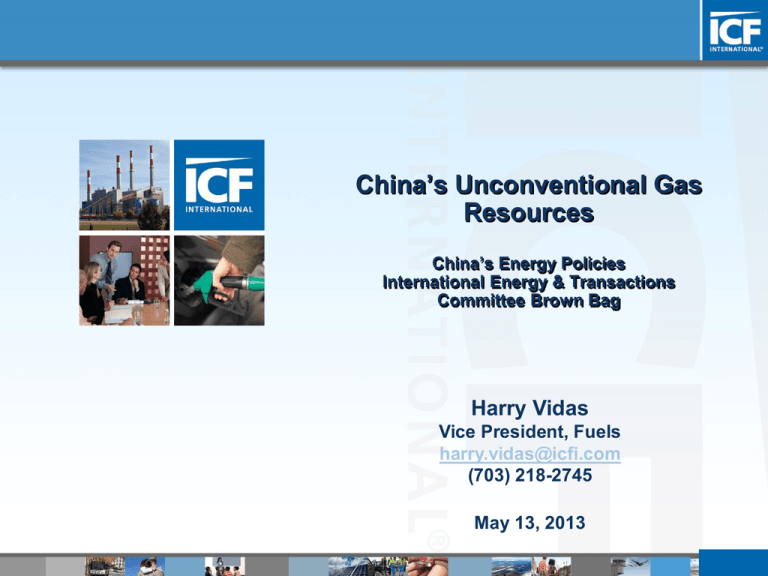
China’s Unconventional Gas
Resources
China’s Energy Policies
International Energy & Transactions
Committee Brown Bag
Harry Vidas
Vice President, Fuels
harry.vidas@icfi.com
(703) 218-2745
May 13, 2013
Disclaimer
Warranties and Representations. ICF endeavors to provide information and
projections consistent with standard practices in a professional manner. ICF MAKES
NO WARRANTIES, HOWEVER, EXPRESS OR IMPLIED (INCLUDING
WITHOUT LIMITATION ANY WARRANTIES OR MERCHANTABILITY OR
FITNESS FOR A PARTICULAR PURPOSE), AS TO THIS PRESENTATION.
Specifically but without limitation, ICF makes no warranty or guarantee regarding the
accuracy of any forecasts, estimates, or analyses, or that such work products will be
accepted by any legal or regulatory body.
Waivers. Those viewing this presentation hereby waive any claim at any time, whether
now or in the future, against ICF, its officers, directors, employees or agents arising
out of or in connection with this presentation. In no event whatsoever shall ICF, its
officers, directors, employees, or agents be liable to those viewing this presentation.
© 2013 ICF International. All rights reserved.
2
Contents
Overview
Shale Gas Development
Shale Gas Development Impediments
Gas Pipeline Infrastructure
LNG Imports and Shale Development Impact
Conclusion
© 2013 ICF International. All rights reserved.
3
Overview – China’s Shale Estimate
48 Major Shale Gas Basins in 32 Countries
According to the U.S. EIA, global technically recoverable shale gas resources (based on
assessment in 32 countries) total 6,622 Tcf, the equivalent of 60 years of 2008 worldwide
natural gas consumption. More accurate number would be 12,000 Tcf for whole world.
The EIA estimates that China holds 1,275 Tcf in recoverable shale gas
Overview – Shale Gas Production Technologies
Conventional and Shale Gas Resources
Hydraulic Fracturing Process
Horizontal drilling and hydraulic fracturing have unlocked previously inaccessible
shale gas resources
Shale gas production has steadily risen over the past decade through use of these
upstream technologies (U.S. shale gas production now makes up 33% of total U.S.
gas production)
Shale gas wells are drilled 8,000-12,000 feet down and then laterally 3,000-10,000
feet
Contents
Overview
Shale Gas Development
Shale Gas Development Impediments
Gas Pipeline Infrastructure
LNG Imports and Shale Development Impact
Conclusion
© 2013 ICF International. All rights reserved.
6
Shale Gas Development – Shale/ CBM Basins
China has seven major
onshore shale basins thought
to contain shale gas, just two
(Sichuan in the southeast and
Tarim to the northwest) are
suited for near-term
commercial development.
China’s shale and CBM
basins are widely distributed,
China’s shale gas production
remains limited to
experimental well drilling in
the Sichuan basin, with
aggressive plans for future
development.
Current activity in Sichuan
Basin (60 shale gas wells
completed).
7
Shale Gas Development – Current Estimates
Shale, tight, and coalbed
methane
Some areas also have tight oil
potential (including Ordos
Basin)
Most of the resource is in
Sichuan Basin region; similar
geologic age to Marcellus
Shale
Region
Basins
Basin Type
Age
Area (sq
km)
Yangtze Region
Northern China
Northwestern China
Western China
Total
Sichuan, Yunnan, Jiangnan
Ordos, Bohai
Junggar, Turpan
Tarim
Cratonic
Cratonic
Foreland
Depression
S, D
C, P
P, J
K, N
900,000
600,000
700,000
500,000
8
Mean
Recoverable
(Tcf)
447
191
206
212
1,056
Shale Gas Development – Current Status
Most current/near term activity in Sichuan
Basin
60+ shale gas completions to date; no
commercial production, but commercial
scale well rates (up to 5 MMcfd for
horizontals and 1.5 MMcfd verticals)
achieved.
Government forecasts of up to 2.8 Tcf
shale production by 2020; “large scale”
commercial prod. forecast by EOY 2015
Date
International
Companies
NOCs
Activity
Oct-07
Newfield
CNPC
Shale gas joint Weiyuan Block,
study
Sichuan
Completed
in 2008
Nov-09
Shell
CNPC
FushunShale gas joint
Yuangchuan
assessment
Bock, Sichuan
Ongoing
Kaili Block,
Shale gas joint Guizhou;
Sinopec
Ongoing
assessment
Huangqiao Block,
Jiangsu
BP
May-09
Statoil
CNPC
Shale gas joint
Sichuan
study
Negotiation
3Q 2010
Conoco
Phillips
CNPC
Shale gas
Sichuan
Pening
4Q 2010
Chevron
Sinopec
Shale gas
exploration
Longli Counti,
Guizhou
Ongoing
Jul-05
Shell
CNPC
Jul-11
ExxonMobil
Sinopec
Shale gas joint Wuzhishan-Meigu
Ongoing
study
Block, Sichuan
Jul-11
ENI
Sinopec
MOU covering
N/A
shale gas
Active Companies: Shell/CNCP
―
―
$2B shale gas capex expected
through 2013; had completed 24 wells
by Nov. 2012; major decision middecade
production sharing contract recently
approved; the first in China for shale
gas
Status
Jan-10
SINOPEC plans 38 MMcfd of shale gas by
2014
Government gas price subsidies for shale
of $1.83 per Mcf; current wellhead price of
about $5.30 per MMBtu; drilling costs of $5
- $12 million per well
Location/Basin
Source: Gao, 2012)
Tight/shale gas Jinqiu Block,
exploration
Sichuan
Ongoing
N/A
9
Shale Gas Development – Production Forecasts
China’s natural gas use made up 4
percent of the energy mix in 2011, though
the most recent 12th five-year plan has a
goal to increase the share of natural gas
to 10 percent by 2020.
Demand currently exceeding production
Government forecast of 8 Tcf/y demand
by 2015 (5 year plan)
China’s National Energy Administration
has a goal of annual shale gas
production of 228 bcf (6.5 bcm) by 2015
and 2.1 Tcf (60 bcm) by 2020, an
ambitious goal, given the experimental
stage of Chinese shale gas drilling and
the technological/geological issues
Production of China’s unconventionals
could alter the recent dynamic of
increasing LNG imports
10
Contents
Overview
Shale Gas Development
Shale Gas Development Impediments
Gas Pipeline Infrastructure
LNG Imports and Shale Development Impact
Conclusion
© 2013 ICF International. All rights reserved.
1
Shale Gas Development Impediments
Potential challenges to shale gas production include limited pipeline access,
water access, limited technical knowhow, lack of sufficient regulatory
enforcement, and geological issues (e.g., deeper formations than those in the
U.S.)
Topography
Depth
Non-marine in NE areas
Water availability
Population density
Infrastructure
Wellhead prices
Environmental Issues
Water: fracking fluid content, chemical
use/reporting, groundwater contamination,
excessive water use, wastewater
treatment/disposal
Air emissions and climate: methane
leakage, other VOCs, drilling equipment
emissions,
Lifecycle emissions: methane emissions
limit environmental gains from natural gas
use
Contents
Overview
Shale Gas Development
Shale Gas Development Impediments
Gas Pipeline Infrastructure
LNG Imports and Shale Development Impact
Conclusion
© 2013 ICF International. All rights reserved.
1
Gas Pipeline Infrastructure – Total Pipelines
As of 2010, China’s total gas pipeline
mileage totaled 24,000 miles, which
includes a gas pipeline network from
Kazakhstan that connects to the
West-East pipeline from Kazakhstan
to Shanghai, a substantial source of
gas for China. China has plans to
develop other West-East pipelines, as
well.
Gas Pipeline Systems
Gas pipelines are owned by the
state
Shale gas likely to require new
lines/expanded capacity
CNCP controls pipelines; may not
allow third party access
Source: EIA, 2012
14
Contents
Overview
Shale Gas Development
Shale Gas Development Impediments
Gas Pipeline Infrastructure
LNG Imports and Shale Development Impact
Conclusion
© 2013 ICF International. All rights reserved.
1
LNG Imports – Terminals
LNG Import Terminals in China
2012
Imports 1.9
bcfd
Existing
terminal
capacity 2.9
bcfd
2.1 bcfd now
under
construction.
Source: Poten & Partners, 2010
Adding in
planned
terminals
would bring
total capacity
[E+UC+P] to
11.2 bcfd.
16
LNG Imports – Global LNG Trade Forecasts
World LNG Demand Forecasts
Historical World LNG Imports by Region (2004-2011)
90
35
ICF
Range
Facts
Global
70
CERI
Poten
60
30
LNG Imports (bcfd)
LNG Demand (bcfd)
80
25
20
15
JKT
50
10
Credit S.
40
5
30
2011
2015
2020
2025
2030
2035
0
2004
Europe
North
America
2005
2006
2007
2008
2009
2010
LNG import demand exceeded 30 Bcfd in 2011, and is expected to grow another 39 to 57
Bcfd by 2035. Wide range of estimates on China’s LNG demand.
2011
LNG Imports – Global LNG Trade Forecasts
Supply Curve of LNG Supply Projects under Construction or Proposed
$15
$14
F.O.B. LNG Cost ($/MMBtu)
$13
$12
$11
$10
$9
$8
All
Non US
US
$7
$6
$5
$4
-
10
20
30
40
50
Bcfd of LNG Export
60
70
80
Globally, roughly 63 non-U.S. LNG export projects are underway or in the planning phase, with an
estimated total capacity of 50.5 Bcfd; other projects are expected, as well
Just as U.S. unconventional production is expected to make a significant impact on global LNG
markets, China’s successful unconventionals development could fundamentally alter global LNG
trends.
Contents
Overview
Shale Gas Development
Shale Gas Development Impediments
Gas Pipeline Infrastructure
LNG Imports and Shale Development Impact
Conclusion
© 2013 ICF International. All rights reserved.
1
Conclusion
China’s current estimates for unconventional gas resources are
significant, with current development seen in selected basins
Successful development of China’s unconventional natural gas
resources could alter the country’s energy mix and international LNG
trade trends, similar to trends seen in U.S. gas development
However, China’s energy growth needs and low starting base for natural
gas consumption could mean limited effects on international natural gas
trends, as domestic demand could still significantly outpace domestic
production
Impediments, including water usage and geological uncertainties mean
that China’s successful unconventional gas development remains
unclear

